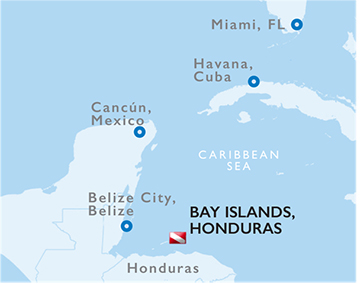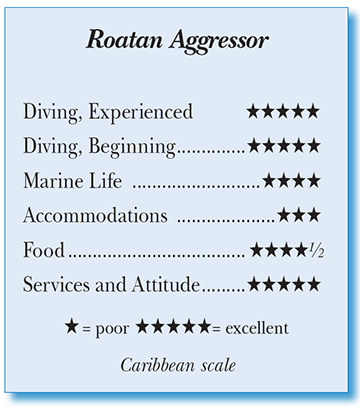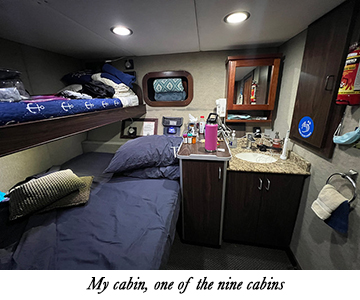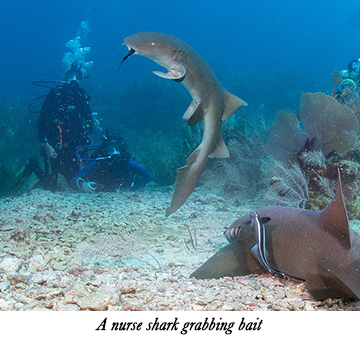Roatan Aggressor, Bay Islands, HondurasContents of this Issue: Roatan Aggressor, Bay Islands, Honduras Stay Away from Those Propellers: The Most Dangerous Thing You Meet is a Boat Who Can Save Dying Reefs? Fish! Climate Change is Eliminating Florida's Male Turtles Raja Ampat, St. Lucia, Rangiroa, Vancouver Island Want to Create Great Videos with Your Action Camera? Instructor Killed by Blasted Tank Valve Have You Seen This Pink Manta? Aqualung Recalls the Exotec BCD Hydration, Diving, and SIPE, the Killer Equipment Checks to Prepare for Diving Editorial Office: Ben Davison Publisher and Editor Undercurrent 3020 Bridgeway, Suite 102 Sausalito, CA 94965 good diving, decent boat, great crew; however... from the November, 2022 issue of Undercurrent
Dear Fellow Diver, In late July, I traveled to Roatan for back-to-back one-week trips on the Roatan Aggressor. While I had planned to stay two weeks, it wasn't long before I asked whether a cabin was available for a third week. There was, and I stayed.
Sharks congregated for baited dives. While I am not a fan of orchestrating wildlife, I wasn't stubborn enough to sit out. So, I was amazed to see a Caribbean nurse shark seemingly leap straight up in front of me, like an Olympian, to snatch a piece of lionfish! Several swam directly at me to retrieve a piece of lionfish that had dropped in front of my camera dome, sometimes bumping or nudging me upward so they could get beneath me. Later, three nurse sharks buddied up with me, occasionally photobombing my shots. To attract reef sharks, the guides kept the bait in a sealed bucket, enticing the sharks (which ranged up to seven feet), along with Nassau, tiger, and black groupers. When they released the bait, it was hit and run. Once, a bearded toadfish emerged from its hole for a chunk of lionfish. Large scaly-tail mantis shrimps seemed to enjoy the thrill of the chase! When the food was gone, the sharks moseyed on, leaving us divers to search for any teeth they left behind. The 110-foot Roatan Aggressor was laid in 1988 and retrofitted as a liveaboard in 2011. It carries 18 divers in nine of the smallest liveaboard cabins (mine was 43 sq. ft., according to their website) I've ever seen, other than the two front cabins of what is now the BVI Aggressor. My mattress in the bottom double bunk was so firm it aggravated my back. While each cabin has its own stuffy head and shower, most of us divers showered in our swimsuits on the swim platform after we took off our gear. Still, there is more to a liveaboard trip than one's cabin, and I must say the Roatan Aggressor had an exceptional crew. Cruise director Gabi Ruben (England) briefed us frequently and clearly. She used her considerable concierge skills to the passengers' advantage. While guiding dives, she was a speed demon but an excellent spotter, so I worked to keep up with her. Joe Price (Roatan), a very service-oriented guy, had just joined the Aggressor. During one night dive, I couldn't find my buddy and called to Joe, who was in the water with us. He sprang into action, quickly tracking her down. Captain Eddy (Utila), a great diver and photographer, became a friend to all of us. He showed me how to frame scenes and coached me on getting beneath a subject to take full advantage of my dome lens. The Aggressor offered four dives daily (the first after breakfast) and four night dives, and I did most. On one night dive at Spanish Bay, Gabi and I were the only divers. I had some trouble in the surface current and eventually lost sight of her. (That week, we had lots of squalls, wind, and overcast weather.) I spent 10 minutes swimming in dark water before we met up at the stern and tried again. Once we got down, a golden coral shrimp was hanging with a toadfish; there were loads of brittle stars and basket stars, an oscillated swimming crab, cardinalfish, buffalo trunkfish, and, hooray, no pesky blood worms. My light brought out the intense colors of the rod coral and whip corals, a great reason to dive at night.
Meals on Aggressor boats have been quite good in my experience, but Roatan was really top-shelf. Chef Jana (Utila) and sous chef Daphne (Roatan) turned out a terrific Mexican buffet lunch, over-the-top desserts, and fantastic soups. For dinner, which was served at five tables seating four each, we had flavorful pork chops, thick and filling tortilla soup, fresh vegetable cheeseburgers --in paradise, tender snapper and mahi-mahi, and a citrus-marinated rainbow runner appetizer that was caught the same day by the engineer's brother! And decent wine as well (no hard stuff on board, but you can bring your own). Chef Jana was always in a festive mood, creating a wonderful vacation atmosphere. Each day she set aside a bowl of soup for me, which I had as a late-night snack. What service! During the first two weeks, we divers had a particularly good time, and in discussions, attributed much of it to the staff's clear communication, hustle, and good cheer. Captain Eddy had the week off during my third week. Owner Alan Roberts (originally U.K., now California), who worked on the Aggressor fleet for more than two decades before buying this boat, flew in to take the helm. He hustled just as much as the crew, used his downtime to mingle with guests, and had a treasure trove of knowledge and fun stories to share. But he displayed an unnecessary edge that sometimes made his customers -- and the crew -- uncomfortable.
There were other incidents of Alan mishandling guests -- gaslighting, if you will -- where we all just shook our heads. His style affected the crew. They had been self-confident people working themselves to the bone, but with him on board, they kowtowed to Alan and couldn't answer any questions without first looking to him for an answer. Frankly, I'm sure he meant well -- he mellowed as the week progressed -- but he did not seem to notice how he was received. It's his boat. No need to prove it. Willie (from Utila) was a terrific guide, slow, purposeful, and good at keeping a group together. At Ted's Point, he had been finding stargazers, a nearly invisible bottom fish with eyes on the top of its head, uncommon on Roatan and nonexistent in most of the greater Caribbean. So here, weekly, we took a live drop dive, submerging immediately to get out of the current. With a guide in the water, we stood in three rows until the crew shouted, "dive dive dive." The first five divers jumped, with the second row following as soon as the divers in the water had cleared. Underwater, everyone followed the guide. At the 45-minute mark, the group rose for a safety stop, the guide deployed his SMB, and we ascended as a tight-knit group. The Aggressor approached, cut the engines, and everyone swam to the boat's port side, allowing the current to take us to the stern and the tow line. Once there, each diver grabbed the line, then moved back to create room for the next diver. The challenging bit was ensuring I didn't wallop anyone with my tank or camera -- we were tightly packed, and the surface was choppy. I made this dive three times, and the stargazers were on vacation for the first two. But I did see a nice toadfish, a snake eel poking his head out of the sand, a tiny octopus, and once an eagle ray flew by. It's a pretty reef, with craggy rock formations covered with plentiful coral and sea ropes and soft corals waving gently in the current. In the third week, the stargazers reappeared. Entry is off the swim platform, generally with a giant stride. To help with my back issues, the crew carried my tank and BC to me and lifted it so I could slip into the BC. Before exit, the guides would remove everyone's fins. I would hand up my camera and weights, and the guide would hand up my tank/BCD to a crew member. One week, the heavy seas at the Grand Cocos seamount caught us by surprise, making it challenging to catch either the boat chain or the dingy line to get back on the boat. The entire crew (including the chef) had prepared for this scenario and was right there, either actively getting divers out of the water or standing by in case another pair of hands was needed. Willie somehow managed to hold down the bucking ladder. After bobbing for minutes, I handed up my camera, doffed my tank and vest, had my fins removed, and got a hand up. It was such a spectacle that divers climbed to the sun deck to cheer on those still in the surging water struggling to exit.
Two passengers had hose failures, which they seemed to blow off. One's i3 inflator bubbled madly, so he just disconnected it. Another's high-pressure hose spewed bubbles all along the hose, but she ignored it so she could continue using her dive computer. The crew said, "no way," and helped her change the computer to a new hose. It's easy to dismiss the i3 situation when you know the workaround, but that complacency can go terribly wrong if another problem crops up during a dive, and a catastrophe may lie ahead when bubbles run the length of the hose. Diving with faulty equipment is the first (and unnecessary) step to disaster. Officially, the Aggressor won't repair anyone's equipment (they'll give you a hand), but there is good rental equipment onboard. One night, after everyone had taken all the photos and videos they wanted of an octopus we found, I stayed behind and gently placed my fingers on some dead coral near the octopus, inviting it to check me out. The octopus reached an arm toward my finger and grasped it lightly. Becoming progressively bolder, it climbed up my hand and forearm. With its suction cups attached, it started to drag my arm to where I was going to come in contact with the reef, so I gently shook it off. Back on board, my fellow divers were excited to have seen that and thanked me for doing it. I said I left it up to the octopus to decide whether it wanted to touch me. I would have left it alone and swum away if it hadn't.
When it comes to Caribbean liveaboards, I think the Roatan Aggressor offers one of the better trips, assuming you don't want to hang out much in your cabin, with an incomparable crew. While occasional choppy water and currents may stress newer divers, this is not only a good craft for a first liveaboard trip, but experienced divers will also find better-than-average Caribbean diving and a few not-so-common critters such as stargazers and mantis shrimp. Enjoy your trip. Authors Bio: Our undercover author does not know when to go home from a dive trip. A divemaster whose spouse has a sense of humor, her granddaughter's 12th word -- "fishy" -- came along this month; Bubblemaker is on the books for June 2029. Though diving is her sure-fire bet for relieving anxiety, she manages to stress herself out with underwater photography. She would like to thank the fairy basslet off Roatan, which stuck around long enough for her to get some decent shots.
|

I want to get all the stories! Tell me how I can become an Undercurrent Online Member and get online access to all the articles of Undercurrent as well as thousands of first hand reports on dive operations world-wide
| Home | Online Members Area | My Account |
Login
|
Join
|
| Travel Index |
Dive Resort & Liveaboard Reviews
|
Featured Reports
|
Recent
Issues
|
Back Issues
|
|
Dive Gear
Index
|
Health/Safety Index
|
Environment & Misc.
Index
|
Seasonal Planner
|
Blogs
|
Free Articles
|
Book Picks
|
News
|
|
Special Offers
|
RSS
|
FAQ
|
About Us
|
Contact Us
|
Links
|
3020 Bridgeway, Ste 102, Sausalito, Ca 94965
All rights reserved.

 You see, many of the dive sites around Honduras' Bay Islands had something unique to offer. Off Roatan, I'll never forget diving close to shore at Black Rock in beautiful sunlit conditions among tiny juvenile butterflyfish and juvenile blue tangs. Off the island of Utila, I saw unique southern stargazers and sizeable scaly-tail mantis shrimp emerging from their hidey holes to claim fresh lionfish. The Grand Cocos seamount was loaded with gorgeous soft coral, schools of blue tangs, and mixed schools of mahogany and yellowtail snappers. A small school of Margate snappers swam among blackbar soldierfish. A trip to Toon Town at Cayos Cochinos offered plentiful blueberry tunicates and Indo-Pacific-quality crinoids. And none of these destinations required much travel, with no overnight crossings.
You see, many of the dive sites around Honduras' Bay Islands had something unique to offer. Off Roatan, I'll never forget diving close to shore at Black Rock in beautiful sunlit conditions among tiny juvenile butterflyfish and juvenile blue tangs. Off the island of Utila, I saw unique southern stargazers and sizeable scaly-tail mantis shrimp emerging from their hidey holes to claim fresh lionfish. The Grand Cocos seamount was loaded with gorgeous soft coral, schools of blue tangs, and mixed schools of mahogany and yellowtail snappers. A small school of Margate snappers swam among blackbar soldierfish. A trip to Toon Town at Cayos Cochinos offered plentiful blueberry tunicates and Indo-Pacific-quality crinoids. And none of these destinations required much travel, with no overnight crossings. In Roatan, you can't swim anywhere without spotting a sharp-nose puffer. The Bay Islands produced a bumper crop of interesting fish. While some areas had more rubble -- basically old, dead coral, occasionally with algae or sponges -- than is ideal, I found most sites very good regarding fishiness, sponges, and corals, often a bit better than Belize. I saw barrel sponges, large midnight parrotfish, and an abundance of juveniles. I spotted black hamlets, a new find for me. There were loads of black durgon -- they're triggerfish, you know -- a few sizeable schools of southern sennets, a tiny nudibranch (the gold-crowned sea goddess), and nice pillar coral. And all this in 84-degree water, with visibility ranging from 70 to 100 feet.
In Roatan, you can't swim anywhere without spotting a sharp-nose puffer. The Bay Islands produced a bumper crop of interesting fish. While some areas had more rubble -- basically old, dead coral, occasionally with algae or sponges -- than is ideal, I found most sites very good regarding fishiness, sponges, and corals, often a bit better than Belize. I saw barrel sponges, large midnight parrotfish, and an abundance of juveniles. I spotted black hamlets, a new find for me. There were loads of black durgon -- they're triggerfish, you know -- a few sizeable schools of southern sennets, a tiny nudibranch (the gold-crowned sea goddess), and nice pillar coral. And all this in 84-degree water, with visibility ranging from 70 to 100 feet. One woman, clearly nervous as she geared up, was fine in the water, but after one messed-up dive, Alan berated her at length for an error, not at all her fault. When another guest said, "that's enough. Let it stand at that," Alan said, "I will continue this discussion until I am finished." That did not sit well.
One woman, clearly nervous as she geared up, was fine in the water, but after one messed-up dive, Alan berated her at length for an error, not at all her fault. When another guest said, "that's enough. Let it stand at that," Alan said, "I will continue this discussion until I am finished." That did not sit well. Generally, the passengers were good divers, with no drama. A mother and daughter -- both GUE divemasters -- were an absolute joy to watch, always graceful and in perfect trim. I planned my photos where they were about to swim because they were ideal dive models! I met a 13-year-old boy (who did quite well in the water) and his father; they hailed from Russia. Chef Jana made him special children's meals.
Generally, the passengers were good divers, with no drama. A mother and daughter -- both GUE divemasters -- were an absolute joy to watch, always graceful and in perfect trim. I planned my photos where they were about to swim because they were ideal dive models! I met a 13-year-old boy (who did quite well in the water) and his father; they hailed from Russia. Chef Jana made him special children's meals. I find real advantages to a multi-week trip. During a single week, I'm really getting "in the groove" around Thursday, but then, it's almost time to go home. By staying another week, I get to know the crew, have the lay of the boat down pat, and feel at home. As a vacationing diver, I'm very comfortable in the water and have perfect dives by the second week. On this trip, I didn't even worry about laundry; on Thursday, they did it for guests who were staying on the following week. Fridays and Saturdays, I went ashore for repeat massages at Pineapple Plaza. I also went to The Yacht Club, where the Aggressor docks, and soon felt like a regular.
I find real advantages to a multi-week trip. During a single week, I'm really getting "in the groove" around Thursday, but then, it's almost time to go home. By staying another week, I get to know the crew, have the lay of the boat down pat, and feel at home. As a vacationing diver, I'm very comfortable in the water and have perfect dives by the second week. On this trip, I didn't even worry about laundry; on Thursday, they did it for guests who were staying on the following week. Fridays and Saturdays, I went ashore for repeat massages at Pineapple Plaza. I also went to The Yacht Club, where the Aggressor docks, and soon felt like a regular. Divers Compass: Saturday-to-Saturday cruises run $3195-$3495/person, double occupancy, plus $295 cash for a port/park/fuel fee upon arrival. The Aggressor website frequently shows discounts . . . . Nitrox is $100/week and ran at 31-33% . . . Chocolate left in room daily, Sea2Stream products provided . . . If you exceed your computer's deco and it locks, you must stay out of the water until it resets, 24-48 hours ... up to five dives per day . . . Aggressor provides airport transportation for $15/person each way . . . If you arrive a day early, the Yacht Club in French Harbor, where the Aggressor docks, offers clean, serviceable rooms, soft beds, a good restaurant, and pool. $85 for a single; $140 double.
Divers Compass: Saturday-to-Saturday cruises run $3195-$3495/person, double occupancy, plus $295 cash for a port/park/fuel fee upon arrival. The Aggressor website frequently shows discounts . . . . Nitrox is $100/week and ran at 31-33% . . . Chocolate left in room daily, Sea2Stream products provided . . . If you exceed your computer's deco and it locks, you must stay out of the water until it resets, 24-48 hours ... up to five dives per day . . . Aggressor provides airport transportation for $15/person each way . . . If you arrive a day early, the Yacht Club in French Harbor, where the Aggressor docks, offers clean, serviceable rooms, soft beds, a good restaurant, and pool. $85 for a single; $140 double. 